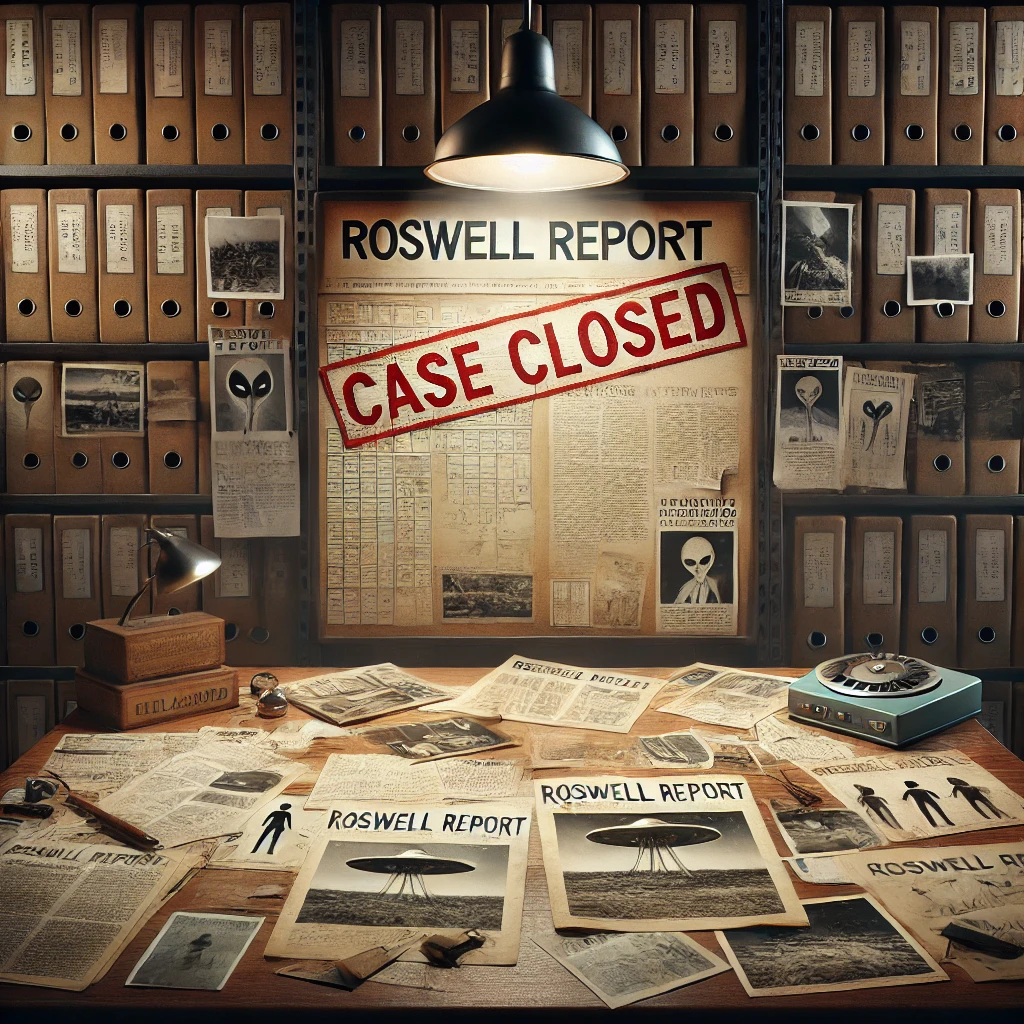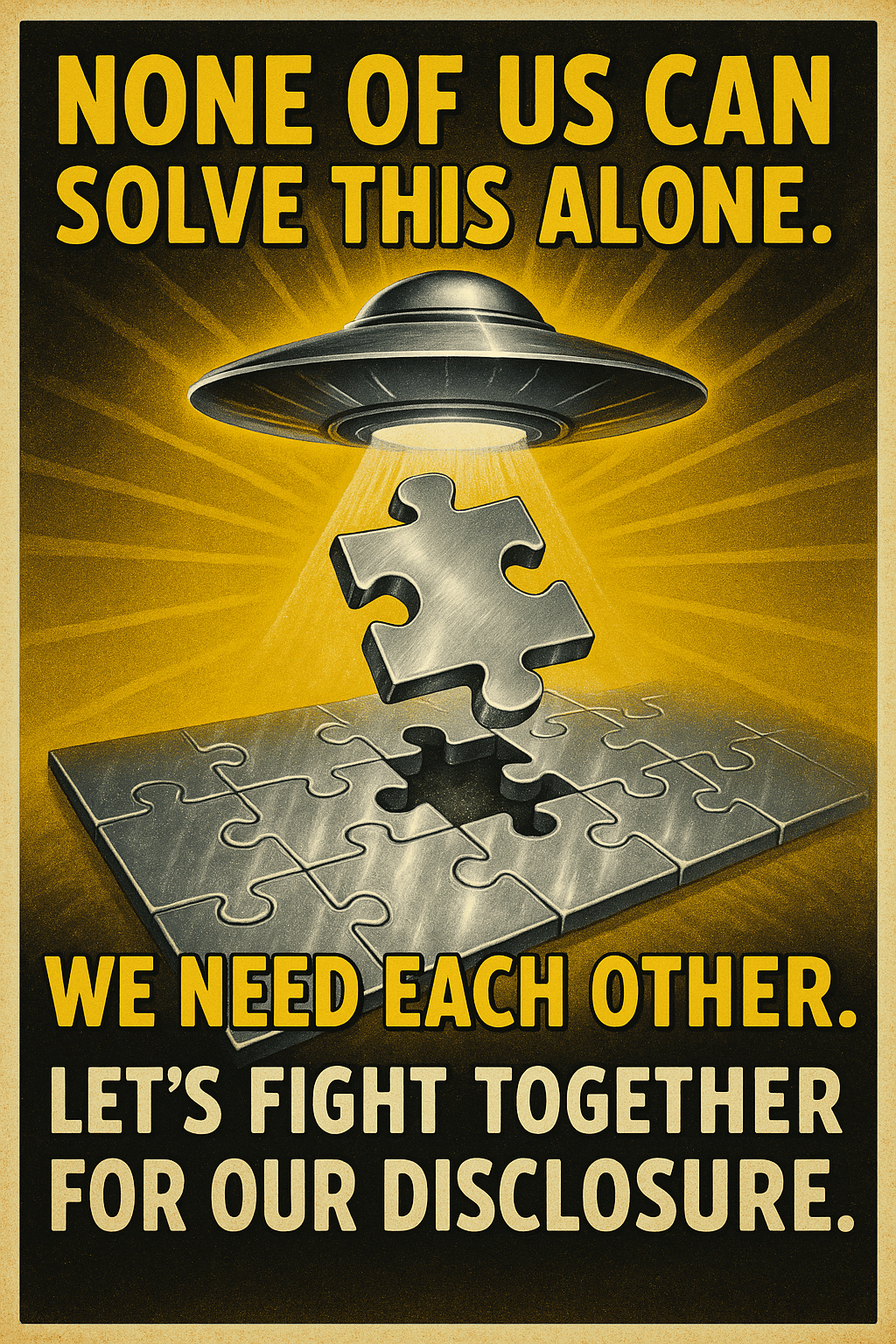Roswell Report: Case Closed—Now Reopened

The U.S. Air Force’s Roswell Report: Case Closed attempts to debunk the idea that an extraterrestrial craft crashed in Roswell, New Mexico, in 1947. Instead, it attributes reports of alien bodies to misidentified anthropomorphic dummies used in high-altitude tests conducted in the 1950s. While the report presents itself as a definitive explanation, it is riddled with logical inconsistencies, factual errors, and selective omissions. The handling of the Roswell case mirrors contemporary concerns surrounding UFO phenomena, particularly in light of recent reports of unidentified aerial objects over New Jersey and the broader U.S. airspace. This raises new questions about the reliability of official disclosure efforts. President Donald Trump has publicly expressed support for UFO transparency, but as seen in past events, including Roswell, there is reason to believe that even the highest levels of government may be receiving incomplete or manipulated information. The ongoing mystery of “Pirate Aircraft” authorized by the FAA adds yet another layer of intrigue, reinforcing the pattern of secrecy and misdirection that has defined the UFO phenomenon for decades. If history is any indicator, the struggle for true disclosure continues to be hampered by selective reporting and the deliberate muddying of public perception.
The Roswell Report: Case Closed is a 1997 U.S. Air Force document written by James McAndrew, aimed at debunking claims that an extraterrestrial craft crashed near Roswell, New Mexico, in July 1947. Published as part of the government’s declassification efforts, the report attributes the infamous debris to Project MOGUL, a secret high-altitude balloon program designed to monitor Soviet nuclear tests. The document, housed on the U.S. Air Force’s official Secrets Declassified website, serves as the military’s final statement on the Roswell incident, asserting that no UFOs or alien bodies were ever recovered.
Major Issues and Inconsistencies
The Air Force’s Roswell Report: Case Closed claims to settle the 1947 incident, but contradictions, missing evidence, and dismissed testimonies tell a different story. By ignoring key witness accounts and offering flawed explanations like Project Mogul and 1950s dummy drops, the report raises more questions than it answers. It’s time to reopen the case and uncover the truth. The people see what is in the skies above New Jersey and around the world—much of the public already knows.
1. The Report’s Foreword and Intent
The report claims to provide a “complete and open explanation” of events surrounding Roswell, yet it selectively presents data while dismissing alternative viewpoints. The assumption that all witness testimony is unreliable unless it supports the official narrative is a clear example of confirmation bias. The foreword by Secretary of the Air Force Sheila Widnall states that the Air Force was a “major player” in events and needed to uncover the facts. However, no original classified documents from 1947 regarding Roswell are included, raising concerns about the completeness of the review.
2. Misrepresentation of Witness Testimonies
The report dismisses firsthand accounts as “anecdotal” while using testimonies from Air Force personnel collected decades later to support its case. Many witnesses who described seeing alien bodies—including intelligence officers and medical professionals—are not properly addressed. The statements of Major Jesse Marcel, the intelligence officer who initially handled the debris and later insisted it was not from a weather balloon, are downplayed or ignored.
Several key figures connected to the 1947 Roswell incident signed sworn affidavits revealing firsthand accounts of the UFO crash, debris, and alien bodies. Walter Haut, the public information officer, admitted witnessing alien bodies and participating in a cover-up. Oliver Henderson, a respected military pilot, claimed to have flown debris and alien bodies to Wright-Patterson Air Force Base. These affidavits contradict the official weather balloon explanation, suggesting deliberate misinformation by authorities.
3. The Timeline Problem: 1947 vs. 1950s Dummy Drops
The report’s central claim is that reports of alien bodies stem from anthropomorphic dummies used in high-altitude balloon tests in the 1950s. However, the Roswell Incident occurred in 1947, making it impossible for people to misidentify dummies that would not exist for at least six more years. The argument that memories became distorted over time does not hold up under scrutiny, as many key testimonies were given by individuals who had clear, immediate recollections of what they witnessed.
4. Project Mogul as a Weak Explanation
The report attributes the debris found in 1947 to Project Mogul, a classified balloon program designed to detect Soviet nuclear tests. However, Project Mogul’s balloon trains contained standard materials—foil, sticks, rubber, and radar reflectors—which do not match the descriptions given by witnesses who handled the debris. Marcel and other witnesses described the debris as having extraordinary properties, such as being incredibly lightweight, resistant to burning, and having memory-metal characteristics. The report fails to explain why a simple balloon retrieval required such a high level of military secrecy and threats against witnesses.
5. The Dummy Drop Theory is Implausible
The Air Force claims that reports of alien bodies were actually descriptions of anthropomorphic dummies used in high-altitude parachute tests. These dummies were over six feet tall and resembled humans, unlike the small, frail-looking beings witnesses described. Witnesses reported non-human features such as oversized heads and large, dark eyes, which do not match the dummies used in Air Force tests. The dummies were also typically found with parachutes, whereas reports from Roswell describe bodies lying on the ground near a crash site.
6. Contradictions in Military Responses
The Roswell Army Air Field originally announced the recovery of a “flying disc,” only to later retract the statement and claim it was a weather balloon. The report does not adequately explain why the military initially treated the incident with such urgency and secrecy. If it were simply a balloon recovery, why were armed guards posted around debris, and why were witnesses allegedly threatened into silence?
7. Omission of Alternative Explanations
The report does not address the testimonies of military personnel who claimed to have been involved in a cover-up. It does not discuss independent lab analyses of alleged Roswell materials that have suggested non-terrestrial origins. Civilian testimony, including that of morticians and nurses who claim to have seen the bodies, is dismissed without thorough examination.
The Ramey Memo was photographed in Brigadier General Roger Ramey’s hand during a 1947 press conference about the Roswell incident. Efforts to decipher the blurred text suggest it refers to a recovered “disk” and mentions managing public perception by misstating the event as a weather balloon. It also includes instructions on securing transportation and classifying photographic evidence. These details imply a deliberate effort to obscure the true nature of the event, fueling suspicions of a cover-up.
8. Flawed Research Methods
The report treats UFO researchers with open skepticism while failing to acknowledge the selective nature of its own sources. Many of the “explanations” provided (such as witness confusion between dummies and alien bodies) rely on speculation rather than documented evidence. The claim that all sightings of military personnel recovering an aircraft were actually dummy retrieval operations is overly simplistic and ignores key differences in descriptions.
Red Herrings and Potential Leaks
9. Red Herrings Used to Distract From Core Issues
The dummy-drop theory is a diversion, as these tests did not occur until years after the Roswell incident. The claim of multiple crash sites is framed as a weakness in witness credibility, rather than considering the possibility of multiple events. Project Mogul is used as a convenient explanation, yet it does not account for the unusual material properties described by firsthand witnesses.
10. Leaks and Accidental Disclosures
The report references Executive Order 11652 (1972), which declassified some Project Mogul records, hinting that others remain classified. Frequent mentions of “body bags” and “caskets” suggest that real body retrievals were mixed with later Air Force operations. The report’s denial of bodies contradicts multiple military and civilian testimonies.
11. Suppressed Evidence and Unanswered Questions
The report does not explain why the initial Roswell press release announced a “flying disc.” Witnesses claim they were threatened into silence, a fact the report ignores. Security measures and secrecy levels far exceeded those needed for a simple balloon retrieval.
Rather than closing the case on Roswell, The Roswell Report: Case Closed inadvertently reveals inconsistencies, omissions, and questionable logic that only add to the mystery. The handling of UFO-related disclosures remains just as convoluted today, with modern sightings such as the unidentified aircraft over New Jersey highlighting ongoing secrecy. Former President Trump’s vocal support for disclosure is a significant political factor, but if Roswell teaches us anything, it is that high-level government officials may not be receiving the full truth. The emergence of “Pirate Aircraft” supposedly authorized for research further complicates matters, suggesting an ongoing pattern of controlled narratives rather than full transparency. The report appears less like a transparent investigation and more like a carefully crafted narrative to reinforce a pre-determined conclusion. The situation is far from ‘case closed.’


